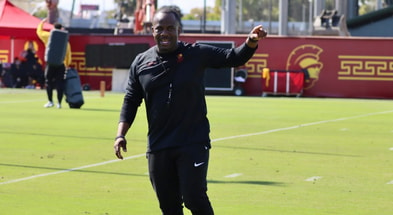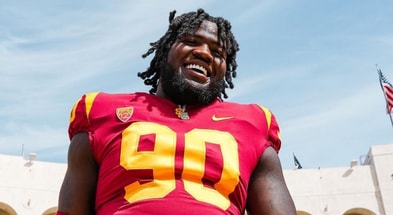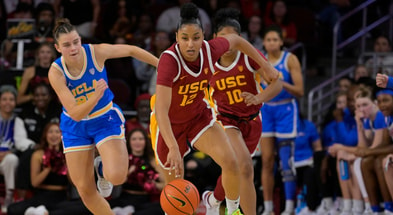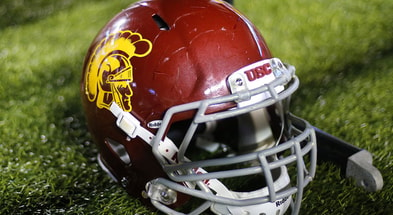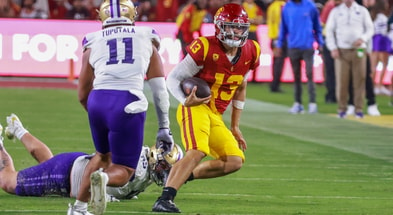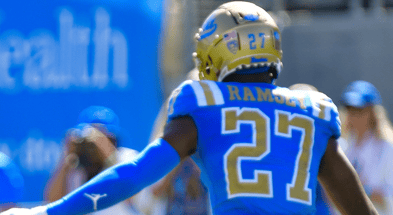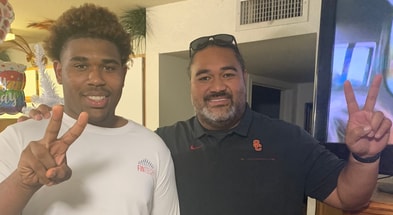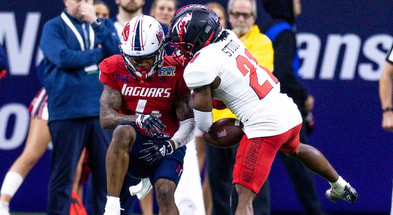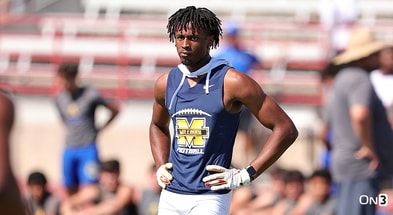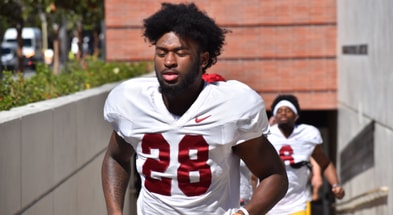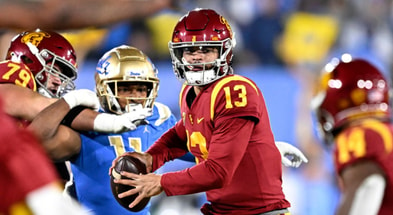Defensively Speaking: USC’s Air Raid or Hybrid Air Raid?
Let me start by saying that our publicly declared new love affair with a transformational offensive change to an Air Raid or Hybrid Air Raid is as profound a shift as was Coach McKay’s moving the 60’s Trojan offense to an I-formation power run scheme combined with a deadly play action passing game. That change lasted almost four decades. The chsnge to Results including four National titles (3- McKay, 1-JR), four Heisman trophies and multiple Rose Bowl wins and conference championships. Ironically, the last time I saw a properly executed I-formation play was during this past Super Bowl by the Pats in a must-have goal line situation. The result was a touchdown and it was 23-Blast (really!) for a touchdown; statement made and ball game over. I could’ve wept.
But now we are now publicly committed to a wide-open Air Raid or Hybrid offense. We don’t know much at all about what this means for USC other than looking at 1) Coach Helton’s comments and 2) Harrel’s UNT offense last season for some guidance and 3) reasoned speculation. So, out of all of that I’ll layout some defensive approaches that can be deployed to defend against this type of attack after describing the Air Raid offense as practiced by OC Harrell last season at UNT.
The Air Raid
I reviewed four University of North Texas (UNT) game films from last season including the shocking 44 – 17 win over SEC Arkansas team in Fayetteville, which is a tough place to play. That said, here’s what I saw after that film review;
- This is a pass first offense. Don’t try dancing around that fact, that is what it is. And that is what Helton wants now. Recruiting needs will need to reflect this approach now.
- Excellent pass blocking is essential for this offense to operate effectively, run blocking is not. Regrettably, that seems to fit our modus operandi these past few seasons. The good news is that this scheme gives our O-line some better angles to attack defenders not just gaps. We’ll have to wait and see.
- The key is the QB must read the defense quickly to find the right pass receiver or check down to a run play.
- Offensive line of scrimmage usually doesn’t have a traditional tight end though H-backs are used in Red Zone and certain short yardage situations. TEs are used on certain first and second downs but usually not in specially situations e.g. 3rdand short, red zone etc.
- All observable games showed no instance of empty backfield; always one RB.
- Play calling is limited while taking advantage of an up-tempo and sometimes no-huddle offense. When there is a no huddle this also means limited defensive substitutions too especially in the red zone.
- Offensive linemen have wider splits than other offenses (except the few triple option teams left e. g. Navy). OL also have a legal slight bowing of the line of scrimmage (LOS). Typical called “fanning” such that each lineman puts their inside foot aligned to the heel of the lineman inside moving from the center outward. The bow has to be less than one yard or its an illegal formation. The principle here is that is creates an additional step for the edge rushers to make to get to the QB. It makes run blocking more difficult for the tackles however. This is an area I would “read” if I were playing defense to get a “tell” for run vs. pass.
- The QB must make his first read pass, run (in that order). Then it’s where and to whom. QB reads safeties or nickel backs depending on defensive set and offensive formation.
- Typical Air Raid formation sets are a 2x2 (two receivers each side, one RB) or 3x1 (three receivers on one side with one opposite WR and RB). The formation vernacular varies a lot with each OC. By the way, these formations were used by our offense occasionally last season but they were not our base offense.
- Formation variations include using an H-back in a wider set formation off a tackle instead of a tight end (who is missing in these formations). The H-back is used to block inside traps, or straight outside zone block in short yardage. Also, most frequently the H-back is put into motion and used in certain pass route trees.
- Red zone formations use more H-back combined with stems and motions. Possible TE use per Coach Helton but I generally I rarely saw a traditional tight end on the field for UNT in the four games I watched in the red zone. When used, the TE was 1stor 2nddown.
- Coach Helton is recently quoted as saying, “…not necessarily Air Raid – I want that to be said. One of the things that really struck me both with Kliff and Graham is they’re different than Coach Leach, who is true Air Raid. You look at Graham’s offense, when you truly study, not only did thy have the 10thleading quarterback in the country, the 10th-ranked passing game in the nation, but they also rushed for 2,000 yards and that’s one of the things that always has to be in your offense is the ability and the threat to garner rushing yards.”
- Well, not exactly a ringing endorsement of run first and we should give up on power running for the foreseeable future. Those days are now over and probably have been for a number of years. We’ll have to leave that type of offense to UW, Utah, Stanford, tOSU, Notre Dame to name a few teams we play quite often.
- Additionally, Helton also said, “It wasn’t the true Air Raid. It was the ability to have an elite passing game that can still emphasize a running back.” Ok, so the one running back is a key element of Helton’s statement. CCH also made note of the use of two tight end sets combined with 11 personnel (one TE and one RB) as the lead (primary) set. I only watched four games but in all four games there was limited tight end use. The primary formation is 2x2 and 3x1 and in the red zone with an H-back. Those are facts and data from four games.
- Other data suggests that Harrell’s UNT offense shows a balance between run and pass plays called with 462 rushing plays and 468 pass plays. First downs were skewed to pass with 108 via rush and 182 via pass. Scoring is another matter though with 28 TDs via the pass and 25 via the run. So, looks like between the 20’s there are more pass looks but when in the Red Zone the offense moved to a run/ pass game balance. Makes sense with the defense backed up and the easier pass reads get much more difficult to execute.
The Defense
As you would expect, there are a number of approaches to defending the Air Raid and its spinoffs. As we show our offense to other teams they will select how to defend. Generally, we’ll see some type of pressure but not just from blitz packages. Actually, there will be gap pressures to unbalance the pocket and force the QB away from their comfortable rollout side (if they have one – usually it’s to their throwing hand side). So here is some of what we expect as we move to a non-Air Raid/Air Raid offense:
- Three down linemen with a 0-tech nose tackle, nickel back, two safeties, two corners, two inside linebackers and one outside backer. The look is zone on the inside with switches made from Nickel to CB to safety.
- Some looks will have single high safety over the in a 2x2 with two wide outs each side with RB. “Quarters” coverage is pretty common here and gives a balanced look on the field. As you would expect there are multiple variations of defensive coverages which I’ll not get into here.
- In the 3x1, expect to see a safety moved over to the trips side the off CB in man with possible underneath help with an outside linebacker. These are the reads the QB has to make to see if a mismatch and move to a running play or exploit the slower linebacker with underneath coverage. Happens all the time as that is a tough cover assignment for a linebacker.
After conferring with a friend of mine who is also one of the premiere defensive minds in college football today (regrettably not on the USC staff…yet) I’ve summarized below some of what he pointed out:
- When defending an offense: you can’t pigeon hole it as a “type” or “style but that every offense is habitual. Behind the play calling is a person – and that person, just like anyone else has habits and tendencies.
- So this offense may be an “air raid”, but you have to look at the type of QB that’s playing (zone read run vs. RPO style), and the type of mentality they have up front with the o-line (run blocking that fires out [Stanford/Utah], or run blocking that ‘positions’ and forces defenders to chase gaps [think Chip Kelly @ UCLA]).
- Once you figure those two things out, the formations begin to make more sense, are they spreading you out to run and be concerned about backside gap control (think of Chip Kelly and last year’s blowout loss), or are they spreading you out in order to attack the second level (WSU and Leach)?
- The Air Raid run game has two styles (as mentioned above), but so does the pass game. Leach style air raid is more of a west-coast based attack with very commonly seen 2 & 3 man route combos seen frequently in the NFL that defenses can match up very well with certain coverages.
- Unlike Leach, there are Air Raids (e.g. Sony Dykes) that attack with vertical routes and RPOs (highly effective against quarters defense due to safety run/pass responsibility). These vertical attacks also use a lot of deep clearing combinations where they attack a coverage and try to get one of the deep defenders out of position.
So here we are waiting for Spring Ball and without knowing anything about what type of offense USC is really going to utilize. Ironically, there is a real opportunity to improve the run game by forcing the opposing team’s linebackers to think vs. attack. Our run game last year was on a good day a very vanilla inside zone (mostly) mixed with vanilla outside zone. The TE was off the ball most of the time so the ability to run zone with pulling guards or center or even a decent gap scheme was limited and predictable. Example, when TE was in next our tackle it was a running play and we occasionally could pull guard and center. Now with the Air Raid run schemes we can layer on the pulling guards, tackles and even centers combined with down blocks giving better blocking angles to the linemen. This is good with RPOs because we’re holding guys in place or subtly moving them out of position and then throw to the now open spot where they used to be.
Time will tell us more about what we can expect to see this coming season, but my guess is that its going to take time and repetition before this offense becomes effective, but it has a real chance. Maybe we’ll love it or maybe not, but it is the direction that Swann and Helton are taking this team. Buckle up, it’s going to be a helluva ride.
